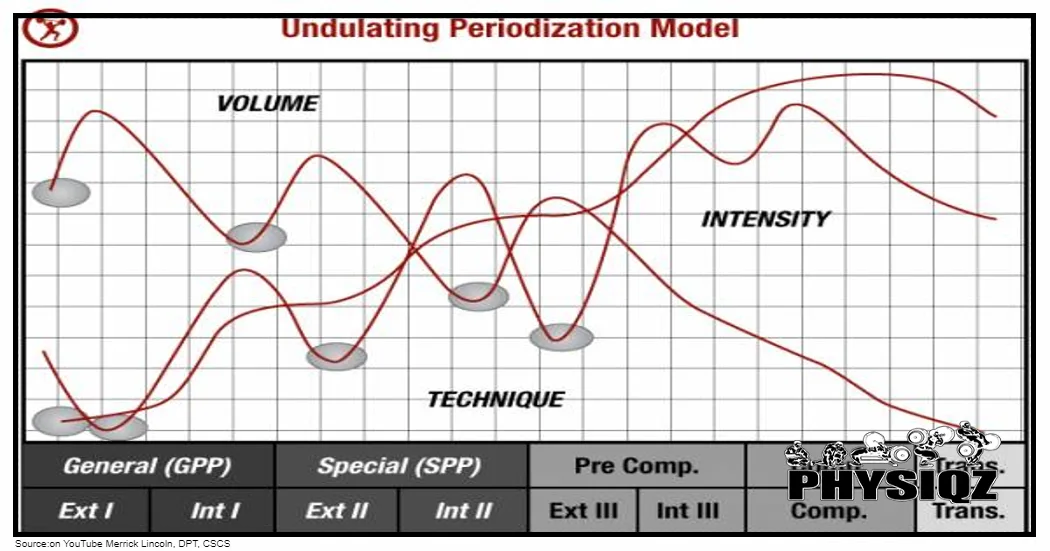
Daily undulating periodization has become a popular approach to strength training for athletes and weightlifters who look forward to getting stronger – ultimately, it’s how pros get strong fast. As seen in the image above, the idea behind DUP is that by manipulating training variables such as volume and intensity on a daily basis, you can more effectively stimulate muscle growth and strength gains.
And in a world of constant change, the only thing that remains the same is change itself. DUP isn’t about “muscle confusion” or any other nonsense preached by gym bros. But if you understand it and use the template effectively, you’ll be able to optimize your time in the gym and maximize gains.
What is Daily Undulating Periodization (DUP) & How Does it Work?
DUP, is a type of training that involves varying the training variables (intensity and volume) of workouts on a day-to-day basis.1 The goal of DUP lifting is to help lifters better make progress by preventing their body from adapting too quickly to their current workout routine.
Ultimately, DUP is a great way to improve hypertrophy, hyperplasia, and neuromuscular conditioning as well as plateaus.2 Plus, it can help you stay motivated since you’ll never be doing the same workout twice!
There is evidence to suggest that DUP is an effective method of training.3 Plus, it has been used by some of the world’s top strength powerlifters such as John Haack and Dr. Mike Zourdos. If you are looking for a new way to approach your weightlifting training, taking advantage of periodization to supercharge your gains is the best way to go.
How DUP Works
The principle behind DUP is that by constantly varying the stimulus, you can avoid plateaus and continually make gains in strength and size.1 This is achieved by combining different sets and repetitions with varying weights of lifts.
DUP works by providing your muscles with constantly changing stimuli, which forces them to adapt and grow.4 For example, you might do heavy sets of squats one day, followed by lighter sets of lunges the next day. This variation helps to fluctuate intensity and volume, which is essential for breaking plateaus while making gains in strength.
Undulated periodization can also be done on a weekly basis (known as weekly undulating periodization, or WUP). With WUP, the volumes and intensities are varied from week to week rather than day to day.2
Other than DUP, there are a few other common types of periodization used in the weightlifting world. As such, it is essential for lifters to be familiar with them so that they might know what method suits their needs and goals.
Other Types of Periodization
These include linear periodization (LP), block periodization (BP), and Conjugate Periodization.
Linear Periodization: Linear periodization is a type of weight training that involves gradually increasing the amount of weight lifted over time.1 The idea is to slowly build up strength and muscular size by starting with lighter weights and higher volumes and then progressing to heavier weights and low volumes.
- Microcycle – a period of several days or weeks
- Mesocycle – lasts several weeks or months
- Macrocycles – last several months or years
Block Periodization: Block periodization is a type of training that involves dividing the training cycle into distinct training phases or blocks.4 Each mesocycle has a specific goal, and the exercises and loads are typically varied from block to block.
For instance, an athlete might want to improve their push-up strength over a 12-week period. This training cycle can be broken into blocks or mesocycles with specific goals as follows:
First 6 weeks: hypertrophy
Middle 4 weeks: strength building
Last 2 weeks: endurance
Conjugate Periodization: Conjugate periodization is a type of training that involves using multiple types of training at the same time. This type of training helps work on different goals simultaneously, such as strength, hypertrophy, and speed. Basically, it improves on the limitations of linear periodization – which focuses on developing one quality at a time.
For instance, a trainee can focus on squat, deadlift, and bench press and vary each exercise during different sessions to achieve different goals. Variations can involve changing grip, stance, or accessory lifts.

Source: StockSnap via Canva.com5
Concurrent Periodization: This method involves training for multiple physical qualities such as endurance and speed at the same time – in one session or mesocycle. There is no specific focus in this method, and the aim is to achieve multi-faceted physical fitness.
For example, a trainee can lift for hypertrophy on Day 1 and lift for strength on Day 2. The trainer can also break down a one-hour training session into small blocks for warm-up, hypertrophy, and strength.
DUP may be more beneficial than other types of periodization, as it allows you to better target different muscle groups and ensure that all muscles are being worked effectively while avoiding overtraining and accommodation.
The Strength Benefits of Undulating Periodization
Several studies reveal that undulating periodization is more effective than linear periodization for developing strength. Some of the benefits include…
- Enhances Neuromuscular Stimulation
Undulating periodization has been shown to enhance neuromuscular stimulation, which can lead to greater gains in strength. In a classic study dating back to the 80s, researchers found that those who used a DUP program saw greater gains in strength than those who used a linear periodization program.3
By varying the training variables on a daily basis, DUP ensures that muscles do not become too accustomed to a particular stimulus, allowing for greater gains in strength over time.
- DUP Helps Manage Fatigue
Another benefit of using an undulating periodization program is that it can help to manage fatigue. This is likely due to the fact that DUP training allows you to recover from hard workouts while still making gains in strength and size.6
This can help to prevent overtraining and keep athletes fresh for competition.
- DUP Is an Ideal Method To Train for Many Competitions
If training for competition, non-linear periodization benefits those with many contests during a season. According to research, It lets the athlete experience high and low intensity, as well as volume, without having to spend a long time doing it – as is the case with traditional linear periodization.6
It can help athletes peak for each individual competition, rather than having the trainees peak for one big competition at the end of the season.
- Undulating Periodization Is Great for Advanced Lifters
One study compared the effects of DUP and LP on strength gains for experienced trainees (an average of 5 years of training experience).7 After 12 weeks of training, the researchers observed a 28.8% gain on the bench press for the DUP group, while the LP group had a 14.4% gain on the same exercise and workload.
These results show that DUP is twice more effective as LP in aiding strength gains.8 For advanced lifters who have already reached their strength potential, DUP can be an ideal way to keep making progress. This is because it provides a strong neuromuscular stimulus, which is necessary for continued progress.

Source: Ibrakovic via Canva.com9
Potential Drawbacks of Daily Undulating Periodization
While DUP results are promising, it is important to note that DUP has some potential drawbacks.
- There Is an Increased Risk of Overtraining
DUP can put athletes at risk of overtraining if not properly implemented. This is because repeated exposure to high-intensity phases can lead to exhaustion and fatigue if the athlete cannot recover properly between sessions.
As such, it is important that athletes who use DUP take care to listen to their bodies and recover adequately between training sessions.
- It’s Not Great for Beginners
DUP might not be the best option for beginners. This is because the constant change in training stimuli can be confusing and make it difficult to progress. Also, there is a greater risk of injury since the body is constantly being asked to adapt to new exercise demands.
This can be especially tough for beginners still learning proper form and technique. In addition, beginners may not have the necessary strength and conditioning to handle the higher intensity phases associated with DUP. You may want to check this beginner guide if you’re a novice trainee.
- The DUP Program Design Might Be Intricate for Some Lifters
A DUP workout routine can be pretty complicated because if the variables are not properly balanced, it can lead to suboptimal results or even overtraining if done incorrectly.
As such, it is generally recommended that DUP be used by experienced lifters who have a good understanding of how to undertake autoregulation training.
- Not Ideal for Training to a Specific Peak of Strength and Power
DUP is not necessarily the best option for athletes training to peak for a specific event. This is because the constant change in training stimuli can make it difficult to properly focus on the event-specific skills and qualities that need to be developed.
The frequent changes in training stimulus can also make it difficult to track progress. This is because comparing results from one day to the next can be hard. In addition, some lifters may find the constant change in routine frustrating and difficult to stick with. For these reasons, it would be better for athletes who are training for a specific event to use linear periodization.
How Do I Program & Progress Using DUP?
To program DUP, start by identifying the major lifts you want to focus on. Then, choose a weight and rep ranges for each lift. For example, you might program for the squat, bench press, and deadlift. From there, you can design your workouts around these lifts in a 4-day powerlifting split, adding in accessory work as needed.
For example, a program for squat might look like this:
- Monday: 4×10 at 70% 1RM
- Wednesday: 4X8 at 75% 1RM
- Friday: 4X6 at 80% 1RM
- Saturday: Accessory work: 3 sets of 10-12 reps or calisthenics for triceps and biceps.
The key is to design a program that undulates between two or more workouts so that there are always new challenges to face. This means that each workout is different, which helps to keep the body guessing and prevents plateaus.
Of course, there are endless possibilities when it comes to programming DUP. The important thing is to make sure that you are constantly challenging yourself and progressing towards your goals.
Progression With DUP
As with any training program, progression is key to success with DUP. The goal is to make small, consistent gains over time to eventually reach your desired level of strength and conditioning.
The key to progression with DUP is to make small, incremental changes to your muscle gain workout plan over time.1, 2 This could mean adding weight, reps, or sets as you get stronger. Or, it might mean increasing the intensity of your workouts by using heavier weights or reducing the rest periods between sets.
The best way to progress with DUP is to make small increases in either intensity or volume on a regular basis. For example, you might start by increasing the weight you are using for each lift by 2.5-5%. You may also want to add an extra rep or two to each set. Or, you might choose to add an extra set to each workout for maximal strength gains.
It’s also important to take a week’s break every 4-week cycle to allow your body to recover fully and prevent overtraining. During this “de-load” period, the trainee can keep the same training volume but reduce the load or intensity by about 50%. For instance, if they were training with 70-80% 1RM, they can reduce the load to about 35-40% 1RM. Other people opt to maintain the same load or intensity but reduce the volume by half – e.g. reduce the number of sets from 4 to 2. Whichever method you choose to de-load will give your body a chance it needs to recover while avoiding any unwanted plateauing in your strength gains.
The most important thing is to make sure that you are constantly challenging yourself and making progress. By doing so, you will be able to make the most of your training and see continual gains in strength and size.
By following these simple guidelines, you can ensure that you are always making positive gains in your strength and conditioning.
DUP Program Templates
A DUP periodization program template is a great way to get started with dup strength training. Templates are flexible such that trainees can modify them in a DUP spreadsheet to suit their needs.
Also, trainees can use DUP program templates alongside the GZCL spreadsheet, optimized using the GZCLP program done in 30 seconds, for optimal results. Below are some examples of DUP templates that you can use to get started.
DUP Bench Template
Below is a DUP bench template that you can use to increase your strength and size.
- Day 1: 4×4 at 80% 1RM
- Day 2: 4×5 at 75% 1RM
- Day 3: 3×2 at 82.5% 1RM
Each week you could add 2.5-5% 1RM to the weights you are using.
DUP Squat Template
If you want to focus on increasing your squat, use the following DUP template.
- Day 1: 5×3 at 85% 1RM
- Day 2: 3×4 at 75% 1RM
- Day 3: 4×5 at 70% 1RM
Once again, you can add 2.5-5% to the weights each week.
DUP Deadlift Template
The following DUP template is ideal for lifters who want to focus on increasing their deadlift strength.
- Day 1: 5×3 at 80% 1RM
- Day 2: 4×4 at 75% 1RM
- Day 3: 4×6 at 70% 1RM
Remember to apply the principle of progressive overload by adding 2.5-5% to the bar every week.
Overhead Press DUP Template
This DUP template is perfect for those who want to focus on increasing their overhead press strength.
- Day 1: 5×5 at 70% 1RM
- Day 2: 3×3 at 80% 1RM
- Day 3: 5×2 at 85% 1RM
As always, add 2.5-5% of weight each week.
Ultimately, DUP is a great way to make continual progress in your strength training journey. By following these simple guidelines, you can create a customized DUP program or follow our spreadsheet in order to progress like the pros.
Frequently Asked Questions
Is DUP Best for Powerlifting?
DUP periodization has been shown to be particularly more effective for building strength compared with linear periodization. From the classical study by Poliquin (1988) to contemporary studies by Rhea et al. (2002) and Miranda et al. (2011), there is an indication that the DUP method is effective for strength gains compared with LP.
By varying training variables frequently, DUP enhances neuromuscular stimulation and causes the body to react to resistance training without adapting. This kind of autoregulatory training serves to mitigate the repeated bout effect, a situation in which muscles become more resistant to training over time.
Is DUP Best for Bodybuilding & Hypertrophy?
In a study on bodybuilding periodization, Kraemer et al. (2003) observed more muscle mass in the group using a varied program compared with the constant group. In another recent study, Schoenfeld et al. (2016) observed that the group with a varied training model got more size gains than the group with a constant model.
Although there was no statistical significance in these groups, the studies indicate that DUP could be better for those taking a powerlifting hypertrophy program. An example of a strength and hypertrophy program is David Laid’s dup program – a 6-day push pull legs (PPL) split.
How Long Are Undulating Periodization Programs?
The length of your DUP bodybuilding or strength training program will depend on your goals and how much time you have to devote to training. Generally speaking, a DUP workout program can last anywhere from 4-12 weeks.
For example, Layne Norton’s DUP runs 12 weeks. There is also an 8-week powerlifting program that incorporates DUP. What’s more important with daily undulating periodization is to vary the exercises, sets, reps, and weights frequently to prevent your body from adapting.
References
1Harries, S. K., Lubans, D. R., & Callister, R. (2015). Systematic review and meta-analysis of linear and undulating periodized resistance training programs on muscular strength. The Journal of Strength & Conditioning Research, 29(4), 1113-1125. Retrieved August 11, 2022, from <https://pubmed.ncbi.nlm.nih.gov/25268290/>
2Zourdos, M. C., Jo, E., Khamoui, A. V., Lee, S. R., Park, B. S., Ormsbee, M. J., … & Kim, J. S. (2016). Modified daily undulating periodization model produces greater performance than a traditional configuration in powerlifters. The Journal of Strength & Conditioning Research, 30(3), 784-791. Retrieved August 11, 2022, from <https://pubmed.ncbi.nlm.nih.gov/26332783/>
3Poliquin, C. (1988). Five steps to increasing the effectiveness of your strength training program. NSCA J, 10(3), 34-39. Retrieved August 11, 2022, from <https://dojo.strengthsenseiinc.com/wp-content/uploads/2020/03/Five-Steps-in-Training.pdf>
4Kraemer, W. J. et al. 2003. Physiological Changes with Periodized Resistance Training in Women Tennis Players. Medicine and Science in Sports and Exercise. January. Vol. 35, No. 1, pp.156-168. Retrieved August 11, 2022, from <https://pubmed.ncbi.nlm.nih.gov/12544650/>
5StockSnap. “Man Doing Push Ups with Weights.” Canva. Accessed 7 April 2023. <https://www.canva.com/photos/MADQ5Kpk9kI-man-doing-push-ups-with-weights/>
6Baker, D., Wilson, G., & Carlyon, R. (1994). Periodization: The effect on strength of manipulating volume and intensity. J Strength Cond Res, 8(4), 235-42. <https://espace.library.uq.edu.au/view/UQ:714223>
7Rhea, M. R., Ball, S. D., Phillips, W. T., & Burkett, L. N. (2002). A comparison of linear and daily undulating periodized programs with equated volume and intensity for strength. The Journal of strength & conditioning research, 16(2), 250-255. Retrieved August 11, 2022, from <https://pubmed.ncbi.nlm.nih.gov/11991778/>
8Miranda, F., Simao, R., Rhea, M., Bunker, D., Prestes, J., Leite, R. D., … & Novaes, J. (2011). Effects of linear vs. daily undulatory periodized resistance training on maximal and submaximal strength gains. The Journal of strength & conditioning research, 25(7), 1824-1830. Retrieved August 11, 2022, from <https://pubmed.ncbi.nlm.nih.gov/21499134/>
9Ibrakovic. “Young Man Performing Hanging Leg Raises Exercise.” Canva. Accessed 7 April 2023 <https://www.canva.com/photos/MADAq0o9yGU-young-man-performing-hanging-leg-raises-exercise/>